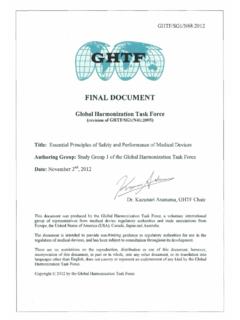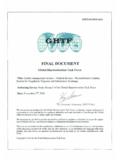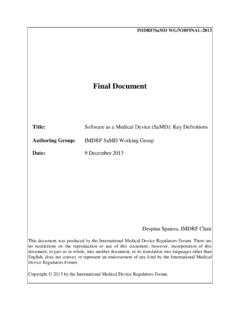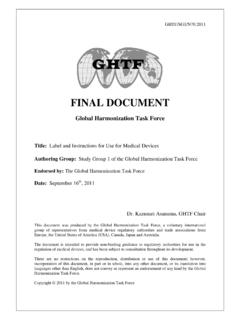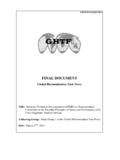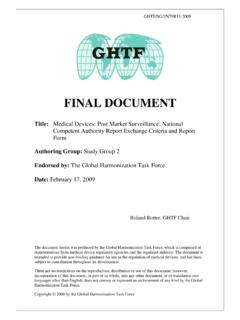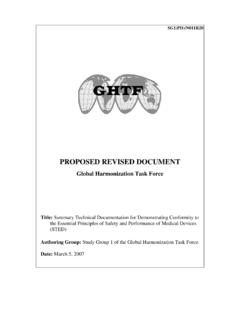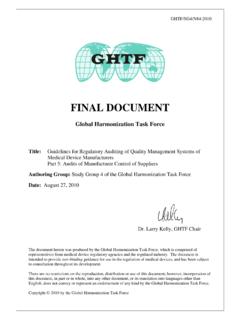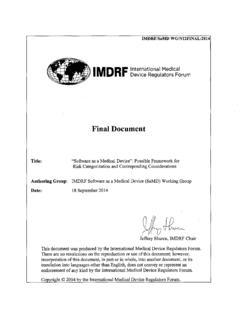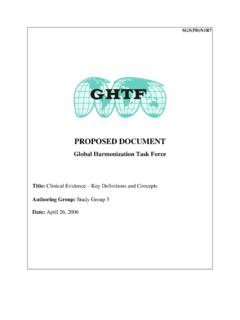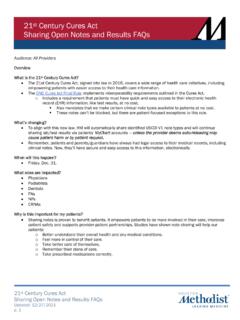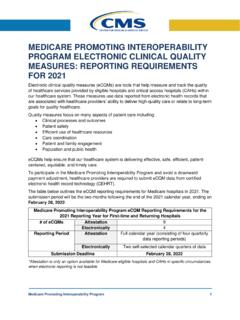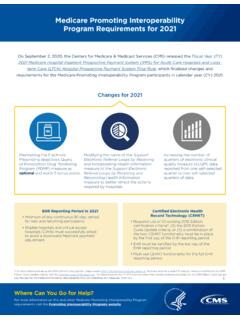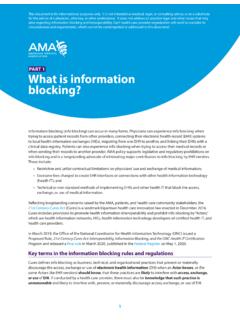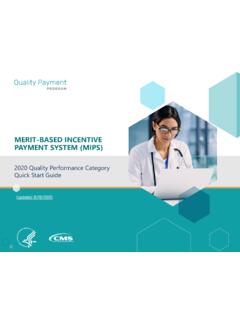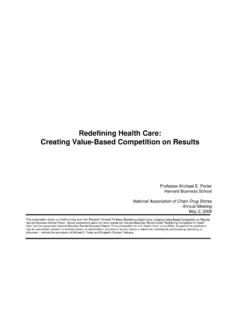Transcription of IMDRF Strategic Plan 2021 - 2025
1 Title: Authoring Group: Date: IMDRF /MC/N39 final :2020 (Edition 2) IMDRF International Medical Device Regulators Forum final DOCUMENT IMDRF Strategic Plan 2021 - 2025 IMDRF Management Committee 25 September 2020 Dr Choong May Ling, Mimi, IMDRF Chair This document was produced by the International Medical Device Regulators Forum. There are no restrictions on the reproduction or use of this document; however, incorporation of this document, in part or in whole, into another document, or its translation into languages other than English, does not convey or represent an endorsement of any kind by the International Medical Device Regulators Forum. Strategic Plan 2021 - 2025 Copyright 2020 by the International Medical Device Regulators Forum.
2 IMDRF International Medical Device Regulators Forum - 2 2 | P a g e Table of Contents IMDRF Mission .. 3 Evolving Medical Device Landscape .. 4 Developing a Regulatory Response .. 6 IMDRF Key Objectives 2021-2025 .. 8 IMDRF Key Priorities 2021-2025 .. 11 Priority 1: Pre-Market .. 12 Priority 2: Post-Market .. 13 Priority 3: Relationships with Stakeholders .. 14 Implementing our Strategic Plan .. 15 3 | P a g e IMDRF Mission The mission1 of the International Medical Device Regulators Forum ( IMDRF ) is to strategically accelerate international medical device regulatory convergence to promote an efficient and effective regulatory model for medical devices that is responsive to emerging challenges in the sector while protecting and maximizing public health and safety.
3 IMDRF2 will pursue its goals by defining, implementing and evaluating Strategic priorities so that objectives are met in an efficient and effective manner. 1 The IMDRF Strategic Plan is aligned with the following mission defined in IMDRF Terms of Reference ( IMDRF /MC/N1 final : 2014; updated 2018) (ToR) 2 Stipulated Under D. Scope of Activities of the ToR IMDRF was launched in 2012 and has delivered a number of significant work products: Continuation of the Global Harmonization Task Force (GHTF) work items, Updates to some of the GHTF documents New work items focusing on regulatory approaches for rapidly evolving technologies in medical devices.
4 IMDRF has focused its attention on developing a total product lifecycle approach to regulating medical devices while enabling timely access to safe and effective devices for the patients . 4 | P a g e Evolving Medical Device Landscape The global medical device landscape is characterised by rapidly evolving technologies. New technologies including the Internet of Things (IoT), 3D printing and artificial intelligence/ machine learning with features such as connectivity, continuous or controlled learning and personalisation have reached the medical device sector. Remote monitoring devices, at-home diagnostic tests, portable imaging equipment and enhanced connectivity have extended the reach of healthcare delivery beyond hospitals and clinics in great parts of the world.
5 Doctors and care givers are able to monitor their patients health statuses remotely and are also able to receive alerts when their patient needs attention thus allowing patients to be effectively managed in the comfort of their homes. patients can be discharged earlier from hospitals by leveraging such remote monitoring technologies thus reducing the burden on our stretched healthcare resources globally. To ensure safety and effectiveness of these new medical technologies and to utilise their great potential requires an appropriate regulatory response to challenges connected with those new technologies. In the context of COVID pandemic, the adoption of telemedicine or virtual consultations was accelerated to enable more efficient use of limited medical resources and to prevent spreading of diseases.
6 While these technologies have proven that significant improvements in healthcare delivery can be achieved even beyond the pandemic, it will be important to pay attention to their safety, effectiveness and data security related issues including securing patient personal information when using them. It is important for medical device manufacturers and regulators to incorporate the current learnings such as regulatory agility and harmonised regulatory principles to collaborate and better prepare for future pandemics or other crisis scenarios. Digital technologies including wearable devices and software including mobile applications have transformed healthcare in many parts of the world to be patient-centric.
7 Consumers are 5 | P a g e increasingly using preventive monitoring and care to improve and maintain their health and to mitigate or avoid the onset of illness. In recent years, the scope of self-monitoring devices for consumers which used to be mainly blood glucose and blood pressure measurements, has expanded to include heart rate, blood oxygen saturation, ECG, arrhythmia and various other physiological parameters. This, together with the permanently increasing extent of available medical information in the Internet, has empowered patients to be more engaged in their healthcare decisions and even disagree with their doctors diagnosis or prescribed treatments ( choice of implants, health screening, surgery).
8 6 | P a g e Developing a Regulatory Response While technology has opened up opportunities to incorporate new features and functionalities in modern medical devices to enhance their performance, it has also posed additional regulatory challenges such as: accessibility, cybersecurity, interoperability , data integrity, and data security etc. Software and digital technologies are capable of improving their safety and effectiveness continuously. For instance, artificial intelligence (AI) medical devices might continuously learn from training with more datasets and their performance specifications are not fixed unlike hardware medical devices.
9 This is challenging the traditional regulatory approaches such as change management process, risk management process, clinical evaluation process, manufacturing facility and process controls, etc. Personalised medical devices that deliver targeted or patient specific therapy for better clinical outcomes are gaining popularity. Personalised treatments including: personalised digital therapies ( cognitive behaviour therapy software for treatment of insomnia) and personalised implants ( orthopaedic implant designed and manufactured to fit an individual patient s anatomy) These necessitate additional considerations to traditional clinical evaluation requirements and clinical study designs.
10 Ensuring the safety, quality and efficacy of these devices without impeding innovation will require suitable adapted regulatory requirements at least on the design, clinical evaluation, risk management and post market surveillance processes. 7 | P a g e The IMDRF Management Committee (MC) is aware of the regulatory challenges within its global regulatory model for innovative devices. In order to manage these challenges and to achieve greater global regulatory convergence and consistency, development and review of regulatory guidance will be necessary. In order to facilitate timely access to safe medical devices for patients , achieving global regulatory convergence for these emerging areas is critical.
